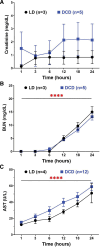Subnormothermic Oxygenated Machine Perfusion (24 h) in DCD Kidney Transplantation
- PMID: 38807861
- PMCID: PMC11132391
- DOI: 10.1097/TXD.0000000000001633
Subnormothermic Oxygenated Machine Perfusion (24 h) in DCD Kidney Transplantation
Abstract
Background: Ex vivo kidney perfusion is an evolving platform that demonstrates promise in preserving and rehabilitating the kidney grafts. Despite this, there is little consensus on the optimal perfusion conditions. Hypothermic perfusion offers limited functional assessment, whereas normothermic perfusion requires a more complex mechanical system and perfusate. Subnormothermic machine perfusion (SNMP) has the potential to combine the advantages of both approaches but has undergone limited investigation. Therefore, the present study sought to determine the suitability of SNMP for extended kidney preservation.
Methods: SNMP at 22-25 °C was performed on a portable device for 24 h with porcine kidneys. Graft assessment included measurement of mechanical parameters and biochemical analysis of the perfusate using point-of-care tests. To investigate the viability of kidneys preserved by SNMP, porcine kidney autotransplants were performed in a donation after circulatory death (DCD) model. SNMP was also compared with static cold storage (SCS). Finally, follow-up experiments were conducted in a subset of human kidneys to test the translational significance of findings in porcine kidneys.
Results: In the perfusion-only cohort, porcine kidneys all displayed successful perfusion for 24 h by SNMP, evidenced by stable mechanical parameters and biological markers of graft function. Furthermore, in the transplant cohort, DCD grafts with 30 min of warm ischemic injury demonstrated superior posttransplant graft function when preserved by SNMP in comparison with SCS. Finally, human kidneys that underwent 24-h perfusion exhibited stable functional and biological parameters consistent with observations in porcine organs.
Conclusions: These observations demonstrate the suitability and cross-species generalizability of subnormothermic machine perfusion to maintain stable kidney perfusion and provide foundational evidence for improved posttransplant graft function of DCD kidneys after SNMP compared with SCS.
Copyright © 2024 The Author(s). Transplantation Direct. Published by Wolters Kluwer Health, Inc.
Figures






References
-
- Jochmans I, Brat A, Davies L, et al. ; COMPARE Trial Collaboration and Consortium for Organ Preservation in Europe (COPE). Oxygenated versus standard cold perfusion preservation in kidney transplantation (COMPARE): a randomised, double-blind, paired, phase 3 trial. Lancet. 2020;396:1653–1662. - PubMed
-
- Mazilescu LI, Urbanellis P, Kim SJ, et al. . Normothermic ex vivo kidney perfusion for human kidney transplantation: first North American results. Transplantation. 2022;106:1852–1859. - PubMed
LinkOut - more resources
Full Text Sources

